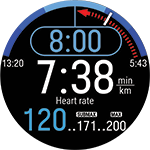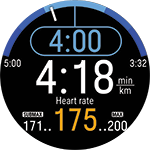Running Performance Test
The Running Performance Test is a tool especially designed for runners allowing them to track their progress and find out their unique training zones (heart rate, speed and power zones) for running sports. By knowing your training zones with the highest possible precision, we can give you individualized training guidance. Regular and frequent testing also helps you plan your training wisely and follow changes in your running performance
How often should I take the test?
We recommend one maximal test for each three months period. The key idea is that you perform the test regularly. This ensures that your training zones are always up to date. If you feel like following your progress more frequently, take submaximal test as often as you like.
Performing the maximal test more frequently isn't often necessary as each test may compromise your training plan due to prolonged recovery as compared to a normal training session. Also, performing the maximal test prior to an important race is not recommended.
Should I perform a maximal or submaximal test?
You can take the test as maximal or submaximal (at least 85 % of your maximum heart rate). The maximal test requires all-out effort, but it gives you more accurate results. The load of the maximal running test is considerably heavier compared to the submaximal test. Therefore, it's recommended that you include only light training sessions in your plan for the next 1-3 days after the maximal test. Taking the maximal test is a good way to find your maximum aerobic power (MAP), maximum aerobic speed (MAS), maximal oxygen uptake (VO2max) and maximum heart rate (HRmax).
The submaximal test, which requires that at least 85% of HRmax is reached or exceeded, is a reproducible, safe and non-exhaustive alternative to the maximal test. The submaximal test gives you a computation of your MAS and MAP based on the test data and your HRmax in your physical settings. You can repeat the submaximal test as often as you wish, and you can also perform it as a warmup before a training session. It's important that your maximum heart rate is set correctly in your physical settings in order to get accurate results from the submaximal test as the submaximal test uses your HRmax when calculating your results. If you don’t know your HRmax, you could benefit from doing maximal test first to find out your maximum heart rate.
The highest weight should be placed on the results from the maximal test. For example, if the submaximal test systematically gives better or worse results than the maximal test, you should rely on the maximal test results.
Test conditions
Take the test in flat terrain, track or road. Choose a location that has no visible uphills or downhills, or obstacles that may force you to stop or slow down. To get the best possible results, choose a location with an unobstructed view of the sky for optimal GPS performance. Always take the test in similar conditions.
Preparing for the test
Reaching your absolute maximum performance requires optimal preparation both physically and mentally. Start preparation by avoiding heavy exertion on the day before the test. Also, follow your normal eating and bed-time routines. You shouldn't feel fatigued prior to test. Finally, remember that our bodies are not machines, and day-to-day variation up to 5% is totally normal. Don't stress about a single result.
The Running Performance Test requires a good state of health. The test sets notably high demands for your cardiovascular, neuromuscular and respiratory systems. Before taking the test, read the Health and Training section in the user manual or in the Important information sheet that came in the product package. Do not take the test during illness, injury or if you have any doubts over your health. Take the test only when you feel recovered. Wear running shoes and clothes that allow freedom of movement.
Good to know
- To complete the test successfully you have to run for at least six minutes and reach at least 85 % or your maximum heart rate.
- The test typically fails when you run too fast or too slow. Follow the speed guidance on the display to avoid failing.
- If your speed deviates from target speed more than +-3 km/h for longer than 10 seconds the test is aborted. Therefore, if you stop running, the test will be aborted after 10 seconds. If the auto-abort occurs after 85% of your HRmax has been reached, you get a result. If haven’t reached 85% of your HRmax, you will not get a result.
- The initial speed can be set between 4-10 min/km. Note that if you set the initial speed too high, you may have you to quit the test too soon.
- If you ran too fast or too slow – your watch will tell you which one – pay closer attention to the speedometer on the display. Note that speed increases slowly during the test. So, avoid quick changes in speed.
- The test uses GPS (GNSS) for calculating your speed, therefore if satellites are blocked by tall buildings, partially covered stadiums or trees accuracy can be compromised. Avoid performing the test in such locations.
- Grit X/Grit X Pro/Grit X2 Pro/Pacer/Pacer Pro/Vantage V2/Vantage V3: By default, the test uses GPS (GNSS) to track your speed but you can also perform the test with a Polar Stride Sensor Bluetooth® Smart or a STRYD running power meter. In this case your speed is measured with the sensor. Note that when using STRYD to perform the test, running power measurement is not available.
- Note that you will not get a Running Index result from your Running Performance Test.
- If you delete a Running Performance Test result, you’ll still have a training file for the session without the test result. In this case the file will not contain a Running Index value.
- The Running Performance Test is based on the University of Montreal Track Test. The University of Montreal Track Test has been compared to laboratory measurements, and large differences haven’t been found between them. Based on this finding, it’s presumed that this test also yields similar results.
Performing the test
- First, define your initial speed for the test in Tests > Running test > Initial speed. The initial speed can be set between 4-10 min/km (default speed is 10 min/km). Note that if you set the initial speed too high, you may have you to quit the test too soon.
- Then go to Tests > Running test > Start and scroll down to see an overview of the test. When you’re ready to start the test, choose Next.
- Check the questions concerning your health and accept to go to the pre-training mode.
- The sport profile is shown in a purple color in the test view. Choose an appropriate indoor or outdoor running sport profile. Stay in the pre-training mode until the watch has found your heart rate and the GPS satellite signals (GPS icon turns green).
- Tap the display or press the OK button to begin. The watch guides you through the test.
- The test begins with a warmup phase (~ 10 min). Follow the guidance on the display to complete the warmup.
- After a proper warmup, choose Start test. Then you need to reach the initial speed for the actual test to start.
During the test
The blue value shows the steadily increasing target speed that you should follow as precisely as possible. The white value below it shows your current speed. The watch notifies you by vibrating if you go too fast or too slow.





The blue arc with the speed values at each end illustrates the allowed range.
At the bottom, you can see your current heart rate, the minimum heart rate required for the submaximal test and your current maximum heart rate value.
When you’re finished your watch will ask Was this your maximum effort? if didn't reach or exceed your maximum heart rate value. Your test is considered submaximal, if your effort wasn't maximal but you reached at least 85 % of your maximum heart rate. Your test is automatically considered maximal, if you reach or exceed your current maximum heart rate value.
Check heart rate sensor is shown if your heart rate cannot be detected during the test.
Speed unavailable, GPS signal lost is shown if the satellite signals cannot be detected during the test.
Test result
The Running Performance Test gives you your maximum aerobic power (MAP), maximum aerobic speed (MAS) and maximal oxygen uptake (VO2max) as results. In addition, if you performed the maximal test you get your maximum heart rate (HRmax) value. You can view your latest result in Tests > Running test > Latest result. The test results are stored in your watch for at least 28 days.

The test result is calculated in your watch but to update your values (MAP, MAS VO2max, heart rate, power and speed zones) you need to have the Polar Flow app on your phone. After the test sync your results to the app to update your values if you wish.
To help long-term follow up, we’ve gathered all the test data in one place in the Polar Flow web service. In the Tests page you can see all the tests you’ve performed and compare their results. You can see your long-term progress and easily view changes in your performance.

What are MAP, MAS and VO2max, and how to use them in your training
The Running Performance Test gives you your maximum aerobic power (MAP), maximum aerobic speed (MAS) and maximal oxygen uptake (VO2max) as results. In addition, if you performed the maximal test you get your maximum heart rate (HRmax) value. You can view your latest result in Tests > Running test > Latest result.
- Your maximum aerobic power (MAP) is the lowest exercise intensity where your body reaches its maximum ability to consume oxygen (VO2max).
- Maximum aerobic power can usually be sustained for a few minutes only. Your maximum aerobic speed (MAS) is the lowest exercise intensity where your body reaches its maximum ability to consume oxygen (VO2max). Maximum aerobic speed can usually be sustained for a few minutes only. MAS is a better indicator of your VO2max than heart rate alone.
- Your maximal oxygen uptake (VO2max) is your body's maximum capacity to consume oxygen during maximum effort.
MAP, MAS and VO2max all reflect your long-distance running performance. They’re markers of aerobic capacity, and the aerobic metabolism supplies more than 90% of your running power in distances covering 3000 meters or more.
- Use MAS when you need training or race guidance and you run on flat terrain and only have access to speed as guidance.
- Use MAP when you are running in hilly terrain and have access to running power.
- Use VO2max as your general non-sport specific performance indicator.